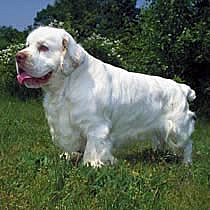|
The Canine Chronicles Directory
Clumber Spaniel

The Clumber Spaniel's feathered coat is dense and soft. The predominately white
coat is straight with lemon or orange markings. This breed is also known to have
freckles on their forelegs and muzzle. The square head should be large and broad
with a pronounced occiput, a heavy brow, a deep stop and well-developed flews hanging
over the lower jaw. The slightly deep set eyes are dark amber in color and the nose
is brown or flesh colored. The large, triangular ears hang forward and are vine-shaped.
The strong jaw has teeth that meet in a scissor-like bite. The shoulders are muscular
and merge into the straight long back. The deep chest is broad and has well-sprung
ribs. The short forelegs should be well-boned and straight. The hindlegs should
be well-developed with low hocks and well-bent stifles. The round feet are large
and covered with hair. The dewclaws can be optionally removed. The well-feathered
tail should be low set and carried level with the back. It is also customarily docked
except in European countries where docking is illegal.
|
|
Temperament
|
Clumber Spaniels are gentle, sweet, and well-behaved dogs. They are also affectionate,
playful, easy-going and steady. They can be slightly willful; however, they enjoy
pleasing their families. Clumber Spaniels love children and are known to be a good
baby-sitters. They also get along with household pets if raised with them. Although
open and friendly with their family, they tend to be reserved with strangers. They
should never be timid or hostile. This breed is primarily used as a pheasant and
partridge hunting dog. Clumber Spaniels are chewers. Due to this, it is best to
have several chew toys lying around the house or other objects, especially footwear,
will be chewed.
|
|
Height, Weight
|
Height: 16-20" ; Weight: 55-85 lbs.
|
|
Health Problems
|
As with larger breed dogs, Clumbers are prone to hip dysplasia. They are also prone
to juvenile lameness, cataracts, dry eyes and entropion. This breed tends to drool,
snore and wheeze. They also love to swallow foreign objects, so take care.
|
|
Living Conditions
|
Clumbers can live okay in an apartment if they are exercised regularly. They are
sensitive to heat because of their dense coat.
|
|
Exercise
|
Clumbers grow very fast and are a very active breed. They love to play fetch so
exercising is easy. They make excellent walking companions. A good walking regiment
will prevent this breed from gaining weight.
|
|
Life Expectancy
|
About 10-12 years
|
|
Grooming
|
This breed requires regular grooming. Check the eyes and ears regularly and trim
ear hair when needed. This breed is a heavy shedder.
|
|
Origin
|
This breed was originally developed by a French nobleman, the Duc de Noailles. Basset
Hounds and St. Bernard's were thought to have contributed to this breed. During
the French Revolution this nobility-owed breed was taken to Clumber Park, the Duke
of Newcastle's estate in England, for safekeeping. The Clumber Spaniel became quite
popular and in 1788 F. Wheatley depicts them in a painting with the Duke of Newcastle.
They were also preferred by several British monarchs including Prince Albert (Queen
Victoria's consort), King Edward VII and King George V. At his estate in Sandringham,
King George V bred many working and show Clumber Spaniel champions. From the end
of World War II to the mid 1960s, this breed declined to near extinction. However,
a few dedicated enthusiasts continued the breed. Today this breed is one of the
most popular in the field and show ring. This breed is recognized by the AKC and
the UKC.
|
|
Group
|
AKC Sporting, UKC Gun Dog
|